Ten Weeks on the Camino: Nick Stark makes his way from Pamplona to Logrono
Pamplona to Puente La Reina (15 miles)
After five days by foot from our starting point in St Jean Pied-de-Port, two rest days in the hectic town of Pamplona were very welcome. But even we can tire of great wines and imaginative tapas, and we were soon ready to strap on our backpacks and continue our trudge westwards. Our first destination lay 15miles away in Puente La Reina, a town named after it’s magnificent bridge. It would not the last we crossed on our Camino. But I’m getting ahead of myself. Leaving Pamplona we spent a couple of hours negotiating its dull urban outskirts before the suburbs gave way to a woody upland sweep along a rocky path lined with hawthorne and blackberry bushes, which took us up to the famed Alto de Perdon at about 2500ft.
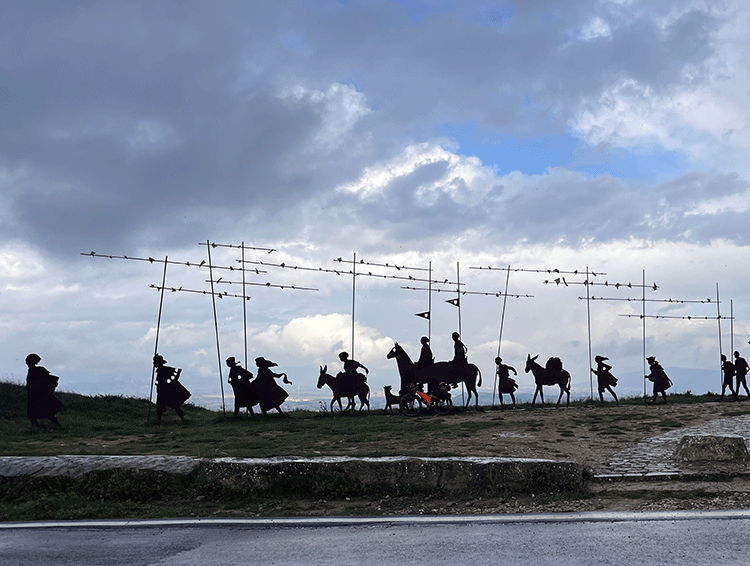
The topography here provides Navarra’s highest winds, birthing an impressive network of wind turbines which feed much of the region’s power needs. The famed artwork at the peak was installed in 1996 and features life-size bronze images of pilgrims, horses and donkeys all heading west, and which (according to my guidebook), is ‘heavy with symbolism of forgiveness both given and received’. Given the buffeting from the wind I was receiving, I was happy enough to snap a selfie and move on without contemplating the subject too long, happy to descend back into groves of Holm oaks, almond trees and wheat fields en route to Puente La Reina.
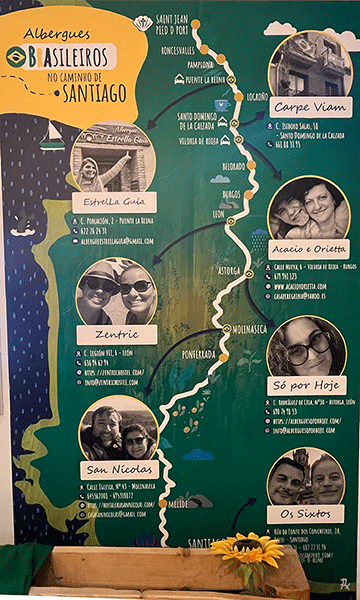
Our bodies had quickly adjusted to walking, but things still started to get painful around the ten mile mark. Ankles, knees, tendons and cartlidge all complained quite loudly as we limped into Puente La Reina, where we checked into the Estrella Guia Solo Peregrinos hostel, a clean and modern space run by a charming Brazilian woman, who fostered a calm atmosphere with meditative music and plenty of aromatherapy in the air. We learned that her place is just part of a network of similar hostelries along the Camino run by Brazilians, all of whom visited as pilgrims before being called back by something within to become hostel owners in their own right. Our delight with this charming town was heightened by a fabulous meal at the Ganbara wine bar just round the corner, where we feasted on local roasted peppers with ventresca tuna, braised leeks with blue goat cheese from a local artisanal cheesemaker, and bacalao (salt cod), washed down with as astoundingly cheap but beautifully structured local Navarran rosé.
And then there’s the town’s bridge, a six arched Romanesque beauty over the river Arga. Magnificently preserved, it makes a perfect Instagram backdrop as you depart en route to Estrella.
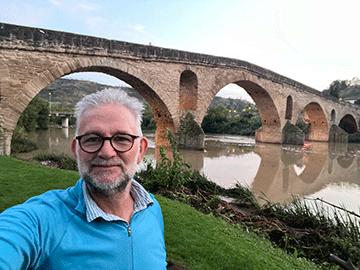
Puente La Reina to Estrella (13.6 miles)
The road quickly turns rocky on this section and winds uphill to a series of picturesque hilltop towns. The highlight is negotiating a 2,000 year-old Roman road between the towns of Ciraqui and Lorca, about seven miles into the day’s journey. The road was part of the Via Trajana back in the first century and cart tracks and cobble stones are clearly visible, even today. Here the Camino farmlands start to yield to vineyards with the approach of the La Rioja region. After a hot, dusty day we were happy to arrive at Estrella, another former Roman town where our hostel perched charmingly on the banks of the river Ega, giving us some wonderful white noise to fall asleep to.
Estrella to Los Arcos (13 miles)
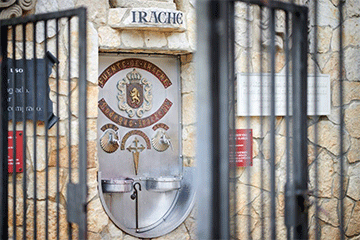
One of the Camino’s most famous places lies just a little outside of Estrella, among the vineyards of the Bodegas Irache winery (www.irache.com). The clever proprietors have installed a ‘wine fountain’ which is really just a tap on the side of their fermentation warehouse where pilgrims are invited to take a sip to help them on their way. Over-indulging or filling your Hydro Flask is possible but strongly discouraged, especially since the fountain has a webcam where folks from around the globe can witness your gluttony. For us, just a sip was enough given the long uphill climb that took us out of the vineyards and back into groves of holly oak and pine trees as we plodded up to Los Arcos. The town is named for Navarra’s famed bowmen who were decisive in a three-way battle for the town back in the 13th century between their king and those of Aragon and Castille. Today it has a bustling main square (plaza mayor), mostly full of pilgrims, and the astoundingly baroque church of Santa Maria de los Arcos, a 14th century wonder boasting a black Madonna (which was quite a thing in these parts, back in the day) and a gorgeously preserved gothic cloister.
Los Arcos to Logrono (16.5m)
The road to Logrono is a long series of dusty dirt roads, wide open skies, and vines. Lots and lots of vines, mostly Tempranillo but with some Garnacha. Since it was still September most of the fruit had not yet been picked, and was hanging juicy and plump on the vine, tempting passersby such as myself. The hills, such as they were, were rolling and gentle but without much shade, prompting us to fill our water bottles whenever we passed through the villages on route.
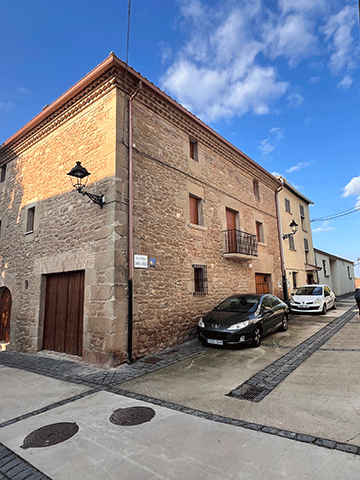
These villages clearly benefit from Camino traffic. Most of the houses look recently built and are in complete visual harmony with 15th century originals they abut. The balconies are awash in colorful windo wboxes of geranium or violas. The streets are clean. The cars, such as they are, are usually late model French or German sedans. And each town has one or two bars for thirsty travelers to whet their whistles with either a ‘caña’ (small draft beer) or a café con leche while wolfing down the requisite boccadillo (little bite) usually a ham and cheese bolillo (roll) or the ubiquitous tortilla espanola, the delicious egg, potato and onion local staple which we turned to almost every day for sustenance.
The dirt road gradually gave way to a paved one and soon enough we arrived at Logrono, greeted (again) by a quite magnificent bridge linking the old town with the new. We gratefully settled into an apartment chosen for its proximity to the Plaza Mayor and its vital amenity – a washing machine. Regular laundry can be quite a challenge on the Camino, and neither of us were keen to smell like vagabonds, so a laundry stop every three days or so was non-negotiable.
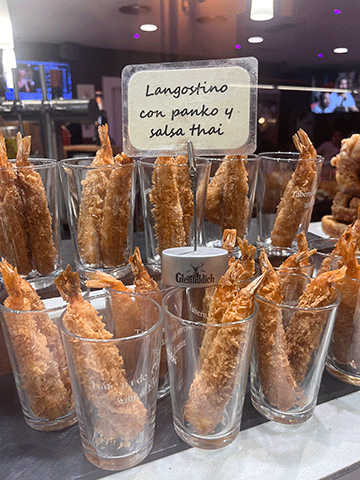
The town itself was a delight – anchored by a bustling main square with a marvellous cathdedral to gawk at, and with dozens of sinuous and inviting alleyways branching off it, heaving with locals enjoying local wines and tapas/pinchos every evening. We spent two days here, indulging as much as possible in the food and wine, which leans heavily on game, with partridges, blood sausage, wild boar and more of their ilk on many menus.
And like Pamplona, where was a fiesta going on. Lucky us. The streets were again filled with drummers and marchers and bibulous celebrants, dozens of whom seemed determined to conduct high-volume debates underneath our bedroom window at 4am.
All part of the fun, I guess.
Next week: Logrono to Burgos.
